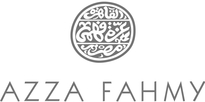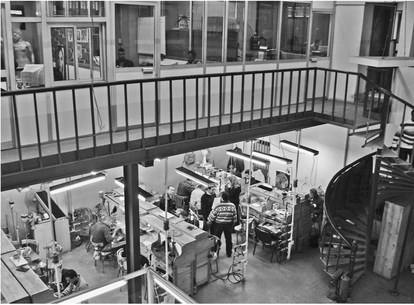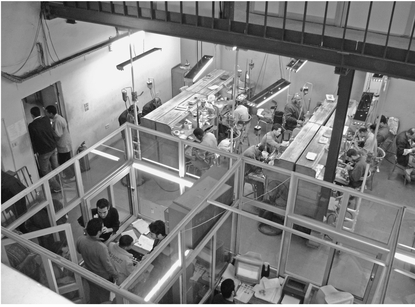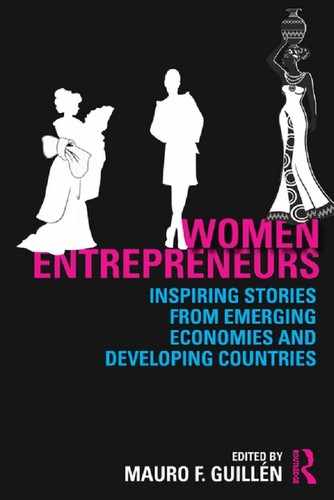12 Azza Fahmy
Egyptian Jewelry
Maha ElShinnawy and Mauro F. Guillén
In Egypt, women were not meant to become apprentices in jewelry making, let alone designers and entrepreneurs. Azza Fahmy defied the odds and launched a high-end line of jewelry inspired by local traditions. Her initial success made it possible to expand the business, add new product lines, establish a large factory, and even pursue foreign sales. Rapid growth, however, led to inefficiencies and organizational troubles, which she sought to overcome by appointing an outsider as general manager, who failed to resolve the problems. The founder then delegated day-to-day management to one of her two daughters, while the other assisted with design. Their challenge was to ensure orderly growth through diversification and internationalization without compromising quality.

Figure 12.1 Azza Fahmy Logo
“It happened in 1974, at the first Cairo International Book Fair,” recalled Azza Fahmy, the Egyptian jewelry designer and entrepreneur.
As I stood leafing through an illustrated book on mediaeval European jewelry, new vistas seemed to unfold before my eyes: a world of beauty, art and intricate craftsmanship. I paid my month’s salary to purchase the book, for I could not leave without it.
At the time she worked for the Egyptian Information Authority, designing book covers. She made inquiries about how she could become a jewelry designer and maker.
In the gold- and silversmiths’ quarter of the Khan [market], I met Osta Ramadan, a man in his early thirties, dark and tall with curly hair. . . . I explained my wish to become an apprentice. . . . [He] thought it a very strange idea since it was the first time a woman had expressed such a wish. . . . He thought it over for a brief moment, then accepted with enthusiasm.1
“So I tied my hair back, put on my overalls and spent my days in a workshop full of men learning the tricks of jewelry making.”2
Becoming an Entrepreneur
Entrepreneurs often lacked the encouragement of their social environment. Moreover, Egypt was a country that scored lower on many indicators of social devel op ment than other countries in the Middle East and North Africa. “My family was not very supportive at the beginning because they could not quite understand what I was doing, but I was very confident about my work,”3 said Azza. “My mother was very sad,” she recalled, “she thought I was crazy, sitting with ordinary workers when I had a good government job.”4 Thirty years later, Azza Fahmy was a US$4 million company, with some 165 employees, boutiques in Egypt, Dubai, and Jordan, and retailing agreements in Quatar, Bahrain, Dubai, and the United Kingdom. About a third of its sales were exports, and another third were sales to tourists visiting Egypt. Her collections included gold, silver, precious and semi-precious stones, and fashion jewelry, with pieces selling from as low as US$100 and up to US$40,000. The company made about 11,000 pieces each year, at an average price of US$330. In 2007 the Financial Times chose Azza as one of the twenty-five most influential businesswomen in the Middle East. The New York Times and the Wall Street Journal also published accolades of her work and business acumen.
“My new experience was out of the ordinary for any conventional, young Egyptian woman in a traditional environment, but I was determined to go on.”5 Azza graduated from Helwan University in 1965 with a degree in ornamentation and decoration. The British Council gave her a fellowship to study at the City of London Polytechnic School, where she sharpened her design skills and learned how to “translate designs into actual jewelry.”6
“When one designs jewelry,” Azza once said, “one has to know how to do it, not only how to draw it, but even more importantly, how to be able to work with the material.”7 Much of her work was inspired by Egyptian arts and crafts, with a touch of European influence. “Everything inspired me, and still does: palm trees, birds, flowers, and the motifs in a house or a piece of proverb.”8 A marketing brochure read:
Her inspiration stems from classical poetry, old proverbs and colloquial sayings—derived from the famous poets and philosophers of the Arab world—as well as her studies of various eras and civilizations with distinctive jewelry traditions–namely Bedouin, tribal, Mogul and Victorian. She then marries these influences with modern touches to create timeless pieces wearable by today’s most contemporary women.
Azza had family ties to Turkey and the Sudan, having been born in the southern governorate of Sohaj. She stood on the shoulders of millennia of fine jewelry making by Egyptians, Armenians, and Turks living in Egypt.
Fahmy’s necklaces capture Egypt’s sights and sounds, intertwining silver beads with desert stones like those that once draped the Pharaohs. They embody the shocking silence of Egypt’s deserts, the smiles of wandering nomads, the rushing palms of distant oases.9
Growth and Organization
The business grew very quickly during the 1970s and 1980s. As Azza noted,
I found that I could not go on alone. I had to create a company, have a production plan and use quality control experts. I used to dream that my work would expand and suddenly I realized that I had a growing business.10
In 1974, she organized her first exhibition and decided to become self-employed. The minister of economy, who happened to be a friend of hers, recommended her for a bank loan of 15,000 pounds (a similar amount in dollars at the time).11 Her first shop opened in 1981 at the El-Ain Gallery in Cairo’s upscale Mohandiseen district, in collaboration with her sister Randa, a designer of Islamic metalwork and lighting, and her then-husband, the architect Nabil Ghaly. In 1997 she opened the Azza Fahmy Boutique in Maadi, a suburb of Cairo, followed by another store in Heliopolis. There were five Azza Fahmy boutiques in Cairo alone. Her customers included the Saudi, Kuwaiti, and Jordanian royal families. For many years she worked out of a cramped workshop in a poor district of Cairo, with twenty people working in two small rooms. She opened a rather spacious factory in 2003—located in the Sixth of October district of Cairo, not far from the great pyramids of Giza—which was later expanded. The ground floor comprised the main workshop area, the raw materials lock room, the planning and quality control sections, and the receiving area. The second floor housed the administrative offices, arranged around a balcony from which the craftsmen could be seen working below (see Figures 12.2 and 12.3). Azza’s office was unassuming. The pictures on the walls reminded one of the many awards and distinctions she had received over the years. One was a signed photograph of Queen Rania of Jordan, a customer.

Figure 12.2 Factory Floor and Second-floor Administrative Offices, Azza Fahmy Factory in Cairo
Source: Mauro Guillén, January 2009.
By the early 2000s Azza realized that the necessary organizational and financial controls were not in place. She was also overwhelmed by the complexities of setting up her own factory and hiring large numbers of workers. In 2004 she decided to focus her energies full-time on design and to appoint an outside manager with experience at a multinational firm. He lasted only a few years, as he became increasingly frustrated by the lack of systems and organization. Upon his resignation, Azza turned to her daughter Fatma Ghaly, appointing her managing director. Her other daughter, Amina Ghaly, assisted her with design and later took on full responsibility for the fashion line and the St. Valentine’s collection. As Azza noted, she did
a fantastic job in bringing together two trends—a fashion style treatment which she combined with a technique that has been widely applied on leather and wood and adding a further edge by translating it using silver while capturing the brand’s unique essence.
According to Azza, having her daughters leading the company “is a dream come true. Amina and I work very closely together. Our thoughts complete one another with her bringing in the modern touch to complement the brand essence.” Fatma’s role as managing director gave Azza

Figure 12.3 Factory Floor: Quality-control Cubicle on Left and Planning Department on Right
Source: Mauro Guillén, January 2009.
“room to concentrate on the designs and undertake the research that goes with this process; we work very closely in terms of strategic business developments and I trust her views on related matters and the general running of the company.” Amina added,
Growing up with someone as passionate and hardworking is very motivating; witnessing her dream becoming what it is today and watching her continuous and tireless efforts makes me believe that I can get to what and where I want by simply working at it.12
Fatma was a fine arts graduate who began working in the marketing department in 2000. During several months in 2003 and 2004 she rotated through various positions to acquire an overall view of the business. In 2004 she became deputy general manager, at the same time Azza had hired the outside director. After becoming the chief executive, Fatma was horrified to find that eighteen different managers were reporting to her, including, for example, the cost-accounting head and the information technology head.
Seeking help, Fatma called her high-school friend, Nadine Okasha. Born in Northern Ireland to Egyptian parents, Nadine had returned to Cairo as a child, studied chemical engineering, started her managerial career in marketing at a local textile company, where she also helped create an operations manual, and then accepted a job at the French sales office of an Egyptian essential oils company. She restructured and ultimately dismantled that office. When Fatma asked her to join the firm in 2006, Nadine agreed on two conditions: access to all internal information and full backing from her friend and boss. She was appointed organizational development manager, with overall responsibility for hiring and organizational structure. One of her main challenges was to unveil hidden thefts. But the greatest task was to reorganize the entire firm. The organizational structure as it was made no sense, and there were no coherent profit and loss statements to guide the reform.
Nadine proposed a structure in which four key managers reported to Fatma: operations, marketing and retail, finance, and organizational development. The operations department, headed by Dalia Kandil, included the design (fifteen employees), planning (four employees), production (eighty-five workers), and warehousing (thirteen workers) sections. Fatma headed the marketing and retail department, where three people worked on marketing and public relations. The company had six boutique managers and about twenty attendants. A plan was in place to turn the boutiques into profit centers that would place orders for the factory. In fact, Azza Fahmy was incorporated as two separate companies, one of which comprised the boutiques. The finance department, run by a man hired specifically for this position, handled accounting, finance, and legal issues. Its offices sat toward the rear of the balcony floor, with plans to move to the expansion next door. This department produced myriad reports and statements. However, the company tended to buy equipment with cash and to expense it immediately, as opposed to amortizing it over its useful lifetime. The organizational devel op ment department, headed by Nadine, comprised two employees who also handled human resource and payroll issues.
The production department was highly stratified, following the Ottoman tradition of jewelry making. Four masters were at the top of the occupational pyramid. The highly skilled workers were aided by the apprentices and their helpers. In addition to the top management and administration, women worked in the warehouse, the raw materials area and the beading room. All workers arrived at 9 a.m. and stayed at the factory until 8 p.m. every day but Friday, taking several breaks for prayers and an hour for lunch. The design section included Azza Fahmy as chief designer and her daughter Amina. The design manager, Aleya Tawfik, was a mechanical engineer who had worked for BMW Egypt, quit her job to raise her two children, and was then hired by Azza. Aleya was also in charge of buying new equipment and tools, such as wax injectors, vacuum mixers, sanding machines, and continuous casting machines. The workers trained on the new equipment for about a month and typically used both the old and the new machines until they were fully comfortable with the new machinery. The quality control section manually inspected every piece, fixing minor problems and sending those with major defects back to production; this unit was located within a glass cubicle in the center of the production floor, adjacent to the planning section. It included three workers and a quality manager who reported directly to Dalia, the operations manager. Quality control was also involved in inspecting the “zero lot,” a set of five pieces that were produced and scrutinized before launching any given collection.
Work Flow Organization and Decision Making
The work flow was quite linear. Aleya, the design manager, explained that it typically began with a brief from the marketing department. Azza or her daughter Amina then worked on a sketch based on research that was normally outsourced to local museums. Then marketing calculated a price range based on the sketch. The draftsmen in the design department on the second floor then used computer-based tools to produce a technical data sheet to specify the materials, dimensions, weight, and overall design. Based on this data sheet, the model makers and the workers on the ground floor produced a prototype that was evaluated by the entire organization, including the retail managers. The necessary dies for stamping the raw materials and applying inscriptions were also produced on the premises at that time. To ensure quality and feasibility, a second complete technical data sheet, called the “patron,” was produced. After repricing by marketing, the design proceeded to the planning section and entered production. The typical lot size ranged between 50 and 80 pieces, each crafted by hand. Special orders for high-end customers or weddings, while relatively rare, were very profitable.
Fatma ran a very tight ship. Design met with marketing every Tuesday. Management meetings moved easily between Arabic and English, although English tended to dominate when the Turkish retail manager was present. All internal e-mail communications were in English. The incentive structure was quite clear and effective. Nadine recalled, however, that the incentive schemes in place in 2006 were perverse and often decoupled from performance. For instance, workers in charge of recycling and exchanging scrap for pure silver were paid a bonus each time they went to the suk, an incentive that led to more silver being wasted. As a result, Nadine linked all incentives and bonuses strictly to performance. Any new incentive schemes had to be approved by the top four managers.
Collections and Marketing
Azza Fahmy’s collections comprised a variety of jewelry. One of her first collections, “Houses on the Nile,” featured jewels shaped like small houses encrusted with palm trees or rocks. Next she turned to renditions of Salah Jahin’s Ruba’iyat (colloquial poems). Later, she incorporated calligraphy from Arabic literature and was among the first designers to combine silver and gold in the same piece of jewelry. Another innovation was in the area of filigrees.
Used as a form of decoration on metals from the earliest times across many cultures and traced all the way back to the Greeks, filigree was a very popular and intricate technique of jewelry making during the Islamic era. The filigree technique basically entails twisting very thin threads of silver or gold to form beautiful lace-like decorations. Due to its very time-consuming nature—it can only be done by hand— filigree was used less and less over the years until it was scarcely used. Today, even when used, silver thread rather than gold is employed as it is easier to shape.13
By 2009, Azza Fahmy sold four product lines: “culture,” “exclusive,” “fashion,” and “gifts & men.” Culture, considered the “trademark” line, each year introduced a new theme inspired by Egypt’s rich history. The collection featured pieces in sterling silver and 18-carat gold and often incorporated semi-precious stones in its designs. The line married traditional workmanship, cultural motifs, and calligraphy to form a modern, stylish, and eminently wearable work of art. Rumuz (“symbols”) was a more recent addition to the culture line. According to a promotional booklet, it
goes beyond the boundaries of jewelry design and art by exploring ancient universal customs and practices to uncover the traditional and diverse symbols that have, over centuries, influenced beliefs ranging from safe travel and protection to good luck and power of revealing secrets.
The firm worked with experts on symbolism for 2 years to design the collection, which included items such as the eye, which
represents a belief that a gaze from an individual thought to be motivated by envy can bring misfortune to the person or object envied. Wearing an eye amulet is used for protection since it serves as an intermediary by catching the evil eye’s negative forces and diverting it from the wearer.
Or the scissors are “believed to grant protection from evil gossip . . . In ancient times . . . people snipped scissors over the heads of brides as if cutting off tongues of evil gossipers.”
The exclusive collection, launched in 2001, represented the couture line at Azza Fahmy. Each serialized, limited-edition piece was traditionally handcrafted in 18- and 21-carat gold. These decorative pieces were adorned with precious stones such as diamonds, emeralds, rubies, and sapphires. The delicate filigree technique was especially highlighted in this collection with accents of precious stones. The subtle use of Arabic inscriptions, combined with the beautiful lace-like designs, made this a truly unique and eye-catching collection.
The fashion line was considered the trendy collection and, according to the company’s website, was “seasonal and ever-changing depending on what is ‘in’ today.” This silver collection incorporated vibrant colored stones and animal prints into a chic, young product line. The jewelry ranged from oversized cuff bracelets to eclectic necklaces to ornamental earrings and rings. This innovative, fashion-forward line targeted a younger audience and was designed by Amina Ghaly.
The “gifts & men” collection featured silver and gold merchandise for all occasions, including corporate gifts. Inspired by the culture line, it offered a selection of unique items for all price ranges. The choices included delicate silver spoons inlaid with gold calligraphy, silver and gold key chains decorated with cultural motifs, and elegant silver picture frames. For men, the line offered an array of jeweled and silver cufflinks and was expanded to include fine leather wallets.
While the company faced very little competition in its culture and gift lines, competition was quite stiff in the exclusive and fashion lines, especially from international firms such as Tiffany and Dior. Fatma observed that the company’s role model was Bottega Venetta (part of the Gucci group) because it had managed to “grow without becoming mass.”
Marketing efforts were focused on magazines, public relations, events, and direct marketing. Marketing expenses amounted to about 12 percent of sales. There was a “no sale–no discounts” policy in place. Launching a new collection in the culture line took up to 4 years. First, research was needed to ensure that the collection spoke to some aspect of cultural traditions. This process could take up to 2 years. Sketching and prototyping required 1 year. The fashion line’s innovation cycle was much shorter.
The company faced a significant problem with copycats. However, Azza always liked to put a positive spin on this issue. “But, look, if someone is copying me, then it means that I’m successful,” she said. “For the last four years we’ve made it difficult to copy us, because our work is very sophisticated, no one with a small workshop can do what we do.”14 Fatma corroborated this point of view by asserting that “it is annoying but not worrying.” In effect, Azza’s designs were very difficult to imitate. The firm had occasionally gone to court, although mostly as a public relations gimmick. As Fatma explained, “initiating legal action is a marketing expense, but you cannot overdo it.”
Strategic Options for the Future
Fatma strongly believed that product diversification and international expansion were the best strategies for growth. She was thinking about and planning for a leather line of wallets and possibly purses and a pen and watch collection. She explained that these products were “natural extensions of jewelry.” She was also considering a line of silverware.
Further foreign growth was a tantalizing possibility. Azza Fahmy faced significant challenges when selling her jewelry internationally. “It’s so different. In Britain and here in the U.S., women don’t like the big jewelry that we do in the Middle East. Once again, one has to understand what they—the customers—like.”15 In the United Kingdom, she collaborated with Julien Macdonald, a designer. “We were both interested in each other’s markets, and fortunately we clicked.”16 She had to adapt her products in many ways. “Maybe [European women] will not understand the verses and not understand the words. For Europe [what] we are planning is taking motifs from various civilizations like Islamic and turning them into modern jewelry [that] people will understand.”17 International expansion also required thinking carefully about the sequence of markets to enter. “We realized that in order for us to do very well in the Gulf, we have to become an international brand,” argued Fatma. “We need to go to Europe or the U.S.”18 Fatma explained that the relationship with Macdonald was great for branding and positioning, but that it was going to be discontinued so that the image of Azza Fahmy would not be perceived as being linked to someone else’s in foreign markets.
Was Azza Fahmy a company prepared to undertake growth on a truly global scale? Should it have focused its efforts on product diversification or on international growth? Were further organizational changes necessary? Could the firm exist without Azza’s design talent? As the top management team pondered the options, the workers meticulously put the final touches on new collections. Azza Fahmy’s strengths as a company remained, after all, in design and craftsmanship.

Notes
1 Azza Fahmy, Enchanted Jewelry of Egypt (Cairo: American University in Cairo Press, 2007), p. 3.
2 Al-Ahram Weekly Online August 30–September 5, 2001.
3 Arab News April 17, 2008.
4 New York Times May 1, 2004.
5 Al-Ahram Weekly Online August 30–September 5, 2001.
6 Arab News April 17, 2008.
7 Ibid.
8 Ibid.
9 Times-Picayune October 3, 1993.
10 Financial Times June 18, 2007.
11 New York Times May 1, 2004.
12 Passion no. 20 (Fall 2008), p. 126.
13 Azza Fahmy’s Facebook page.
14 Arab News April 17, 2008.
15 Ibid.
16 Financial Times September 13, 2008.
17 CNN, May 9, 2008.
18 Wall Street Journal December 28, 2007.
